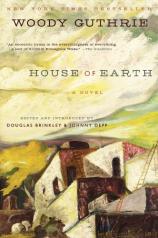House of Earth
Review
House of Earth
The manuscript of Woody Guthrie’s only finished novel, lost to the public for 65 years, has been brought to light in celebration of his 100th year. Guthrie began writing HOUSE OF EARTH during the Dust Bowl years at the apex of his career as a balladeer and champion for the working class. He didn’t finish it until 1947 and sent it off to Hollywood with the intention of it being turned into a movie. HOUSE OF EARTH portrayed a different view of the hard-scrabble life of the Depression Era, so eloquently portrayed in John Steinbeck’s THE GRAPES OF WRATH, which told the story of people leaving the Dust Bowl in search of the land of milk and honey.
In an introduction written by New York Times writer Douglas Brinkley and Johnny Depp, who co-produced the book, Guthrie’s characters are depicted as “…those stubborn dirt farmers who remained behind in the Great Plains to stand up to the bankers, lumber barons, and agribusinesses that had desecrated beautiful wild Texas with overgrazing, clear-cutting, strip-mining, and reckless farming practices.”
"Pithy, primal and raw with emotion, HOUSE OF EARTH is written more as a poetic narrative than what one would consider a structured novel. If you are not familiar with Guthrie’s legendary music, lyrics, poetry, essays and memoirs, his portrayal of the American spirit of the humble man and his legacy is worth exploring."
The iconic songwriter and poet, best known for his folk ballad “This Land is Your Land,” was the voice of Everyman --- the men and women of the soil who scratched to survive the Great Depression and the Dust Bowl years. His was the voice of the people of his own experience.
Guthrie writes in the vernacular of the Texas panhandle. His characters, with all the strengths and weaknesses of plainspoken folks, come to life with their dreams. Tike Harmon and his wife, Ella May, live in what would have been described as squalor even in those days, the rickety wooden shacks of tenant farmers and sharecroppers of America’s plains. Ella May wages a futile battle to create a home against the dust, bugs, heat, cold, wind, rain and snow that seep through the wood lath siding.
Guthrie was enamored of the indestructible qualities of adobe. A man could build a house from the very earth it stood on by himself. He marveled at the Taos Pueblos of New Mexico built from adobe brick that had withstood centuries of assault from nature’s three most destructive elements --- fire, water and wind --- and widely promoted its use in the arid southern plains. He uses wood as a metaphor for what is wrong with America --- its consumptive use brings material gains to those who build with it and comfort to those who live within. But, he points out, eventually the elements will rot it with decay, insects, fire and wind. A solid house made of earth lasts forever.
More than anything, Tike Harmon wants that for his beloved Ella May and a coming child, a foundation that will last forever. The only obstacle to fulfilling his dream is that the law does not allow such a permanent structure to be built on rented land, and the prospects of Tike and Ella May ever becoming landowners are dim indeed.
Pithy, primal and raw with emotion, HOUSE OF EARTH is written more as a poetic narrative than what one would consider a structured novel. If you are not familiar with Guthrie’s legendary music, lyrics, poetry, essays and memoirs, his portrayal of the American spirit of the humble man and his legacy is worth exploring. Utopian in point of view, Guthrie was considered a leftist in his time, even a socialist. He was suspicious of the government, a non-conformist who wanted to live his life unfettered by social constructs. In today’s world, he would not neatly fit into any niche --- especially not a socialist one. He was, as they say, the “real deal”: a fiercely independent individualist who loved America to its very core.
Reviewed by Roz Shea on February 15, 2013
House of Earth
- Publication Date: October 22, 2013
- Genres: Fiction, Historical Fiction
- Paperback: 288 pages
- Publisher: Harper Perennial
- ISBN-10: 0062248405
- ISBN-13: 9780062248404





